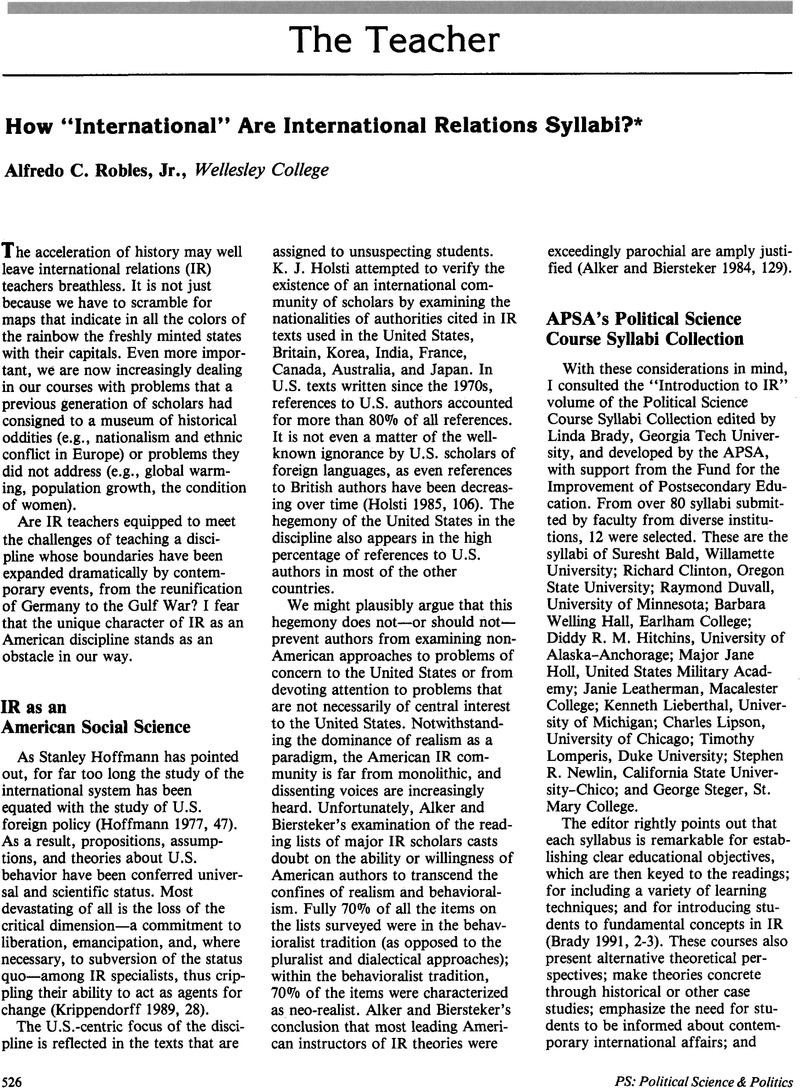No CrossRef data available.
Article contents
How “International” Are International Relations Syllabi?
Published online by Cambridge University Press: 02 September 2013
Abstract
An abstract is not available for this content so a preview has been provided. As you have access to this content, a full PDF is available via the ‘Save PDF’ action button.

- Type
- News
- Information
- Copyright
- Copyright © The American Political Science Association 1993
Footnotes
*
I am grateful to my colleague Wilbur Rich for bringing the syllabi collection to my attention. My thanks also go to Naeem Inayatullah, Audie Klotz, and Craig Murphy, who kindly gave comments on an earlier draft.
References
Abi-Saab, Georges, ed. 1980. The Concept of International Organization. Paris: UNESCO.Google Scholar
Alker, Hayward R. Jr., and Biersteker, Thomas J.
1984. “The Dialectics of World Order: Notes for a Future Archaeologist of International Savoir Faire.” International Studies Quarterly
28: 121–42.CrossRefGoogle Scholar
Alvarado, Elvia. 1989. Don't Be Afraid Gringo, trans, and ed. Benjamin, Medea. New York: Harper and Row.Google Scholar
Amin, Samir. 1977. “The Problems of the ‘Environment.’” In Imperialism and Unequal Development. New York: Monthly Review Press.Google Scholar
Barraclough, Geoffrey. 1967. An Introduction to Contemporary History. Harmondsworth, Middlesex: Penguin Books.Google Scholar
Brady, Linda. 1991. “Introduction to International Relations.” Political Science Course Syllabi Collection. Washington, DC: American Political Science Association.Google Scholar
Brenner, Robert. 1991. “Why Is the United States at War with Iraq?” New Left Review
185: 122–37.Google Scholar
Cassese, Antonio. 1986. International Law in a Divided World. Oxford: Clarendon Press.Google Scholar
Chomsky, Noam. 1991. “After the Cold War: U.S. Foreign Policy in the Middle East.” The Jewish Quarterly. January.Google Scholar
Enloe, Cynthia. 1990. Bananas, Bases and Beaches: Making Feminist Sense of International Politics. Berkeley: University of California Press.Google Scholar
Halliday, Fred. 1989. “State and Society in International Relations: A Second Agenda.” In The Study of International Relations: The State of the Art, ed. Dyer, Hugh C. and Mangasarian, Leon. London: Macmillan in association with Millennium: Journal of International Studies.Google Scholar
Hassner, Pierre. 1990. “Europe beyond Partition and Unity: Disintegration or Reconstitution?” International Affairs
66: 461–75.CrossRefGoogle Scholar
Hoffmann, Stanley. 1977. “An American Social Science: International Relations.” Daedalus
106: 41–60.Google Scholar
Hoffmann, Stanley. 1989. “A Retrospective.” In Journeys through World Politics: Autobiographical Reflections of Thirty-four Academic Travelers, ed. Kruzel, Joseph and Rosenau, James N.. Lexington, MA: D.C. Heath and Company.Google Scholar
Holsti, K. J.
1985. The Dividing Discipline: Hegemony and Diversity in International Theory. Boston: Allen and Unwin.Google Scholar
Jenkins, Rhys. 1987. Transnational Corporations and Uneven Development: The Internationalization of Capital and the Third World. London: Methuen.Google Scholar
Kegley, Charles W. Jr. and Wittkopf, Eugene R.
1992. World Politics: Trend and Transformation, 4th ed. New York: St. Martin's Press.Google Scholar
Krippendorf, Ekkehart. 1989. “The Dominance of American Approaches in International Relations.” In The Study of International Relations: The State of the Art, ed. Dyer, Hugh C. and Mangasarian, Leon. London: Macmillan in association with Millennium: Journal of International Studies.Google Scholar
Lundestad, Geir. 1991. East, West, North, South. Major Developments in International Politics 1945-1990. New York: Oxford University Press.Google Scholar
Pettman, Ralph. 1991. International Politics: Balance of Power, Balance of Productivity, Balance of Ideologies. Boulder: Lynne Rienner Publishers.Google Scholar
Viotti, Paul R. and Kauppi, Mark V.
1987. International Relations Theory: Realism, Pluralism, Globalism. New York: Macmillan.Google Scholar
Waever, Ole. 1990. “Three Competing Europes: German, French, Russian.” International Affairs
67: 453–72.Google Scholar




